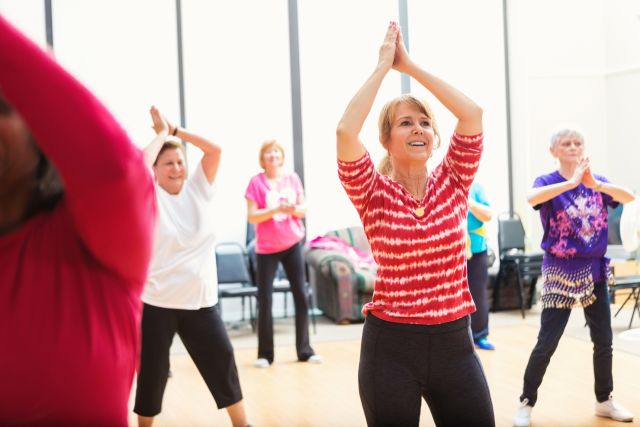Updated on October 13, 2022.
If you have chronic pain or aching joints, you may have the impulse to seek relief via rest, ice, ibuprofen, or a prescription from your healthcare provider (HCP). While those conventional treatments are valuable, movement is not off-limits for pain patients. In fact, depending on your circumstances, exercise may be recommended to help loosen joints and ease pain.
A variety of low-impact moves may help. These include walking, swimming, biking, yoga—even dance. That’s right: Research has shown that dance therapy can decrease physical pain and improve the mental and emotional symptoms that often accompany it.
Understanding dance therapy
The first thing to know is that dancing for wellness probably won’t involve mirror balls and illuminated dance floors. The method often used to improve health is known as dance therapy or dance/movement therapy (DMT). It’s a holistic practice that uses dance and movement as a form of psychotherapy. The goal is to promote mobility and physical health while drawing connections between the mind and body to boost emotional, social, and cognitive well-being.
If you’re worried that you’re too achy to dance, there’s good news: Most people can do DMT, just as they are.
DMT doesn’t consist of choreographed dance, but rather includes components like focused breathing, rhythm, and subtle movements. It can be performed while seated and may include verbal aspects along with physical movements. There is often a strong social component to the classes, which don’t require any previous dance experience but focus on increasing motion. In addition to chronic pain, it can be used to help relieve some of the fatigue and other symptoms associated with Parkinson’s disease, heart failure, and cancer.
Benefits for aching joints
A 2022 article in the journal Pain Medicine analyzed studies of more than 1,200 participants, a majority of whom were women with either fibromyalgia or generalized chronic pain. In the various papers, people took part in dance therapy for about an hour, one to five times per week, for about three months on average.
Seventy-four percent of the studies showed some reduction in pain level in people taking dance therapy. All studies found that participants improved some aspects of their condition, including accepting their bodies’ changes, reducing fear of movement, and gaining a better understanding of their bodies. In the analysis, researchers found that aerobic dance, DMT, and Biodanza (another form of movement therapy) were the most frequently used treatments.
One 2014 study from researchers at St. Louis University used a type of dance therapy called Healthy-Steps, which is designed to improve strength and flexibility. This slow, rhythmic form of dancing was done sitting or standing with 34 older adults who had pain or stiffness in their knees or hips. The people were split into two groups: Members of one group went to dance classes for 45 minutes one or two times a week for 12 weeks, while the other participants didn’t dance.
At the end of the 12-week study, participants in the dancing group not only had less knee and hip pain, but they were able to walk faster as well. The dancers’ use of pain medicine dropped by 39 percent, while people who didn’t dance needed 21 percent more medicine.
While the improvement in walking speed wasn’t dramatic, researchers speculated that even modest gains in mobility could improve people’s daily lives. Older adults who have difficulty walking are more likely to suffer falls, to be hospitalized, or to need care by others.
Dance may also ease headache pain
One small 2021 study published in Frontiers in Psychology found that dance therapy reduced pain and depression in people living with chronic headaches. Of the 29 women taking part in the study, 50 percent of those in the group using DMT had reduced pain levels as well as fewer symptoms of depression and anxiety after treatment. Non-dancers’ pain levels were mainly unchanged.
A potential remedy for chronic pain
Approximately 20 percent of people in the United States have some form of chronic pain. Living with consistent pain can impact a person in several ways. To avoid pain, you may limit your activity, which can lead to less mobility. The inability to do daily activities over time can lead to dependence on others and feelings of depression and anxiety.
Physical activity, however, can combat many of the issues associated with chronic pain. Activity can improve mood and sleep habits, build muscle strength, reduce fatigue, and decrease levels of inflammation. Dance therapy, in particular, can ease many of the challenges people face when managing long-term pain.
In one small 2017 study published in the European Journal of Integrative Medicine, researchers provided DMT to 22 people with chronic pain. After 10 weeks of therapy, participants not only had fewer pain symptoms, but reported feeling more resilient and had less fear of movement, improved relaxation, and a greater connection with others.
Is dance therapy right for you?
The body of research on dance therapy is still relatively small. But findings thus far suggest that dance therapy and related forms of therapeutic movement may be an option for people living with various kinds of pain.
Importantly, dance therapy aims to treat the entire individual, rather than specific body parts. Not only can it help reduce the physical symptoms of pain, but it may also foster social bonding, improve the mind-body connection, and teach coping skills that are critical for any pain management therapy.
If chronic pain—whether joint pain, body pain, or headaches—are a concern for you, ask your HCP if dance therapy may be something you can consider. It may help you see your body in a new light, focusing less on its limitations and more on its many abilities.






